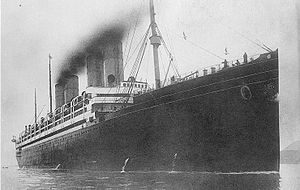 The largest Kaiser-class liner, Kronprinzessin Cecilie
| |
| Class overview | |
|---|---|
| Builders | AG Vulcan Stettin, Germany |
| Operators | North German Lloyd (NDL) |
| Built | 1897–1907 |
| In service | 1897–1940 |
| Completed | 4 |
| Lost | 1 |
| Retired | 3 |
| General characteristics | |
| Type | Ocean liner |
| Tonnage | 14,349 gross register tons (GRT) |
| Displacement | 24,300 long tons (24,700 t)[1] |
| Length | 655 ft (200 m) |
| Beam | 65 ft 9.6 in (20.056 m) |
| Draft | 27 ft 11 in (8.51 m) |
| Installed power | 33,000 ihp (25,000 kW) |
| Propulsion |
|
| Speed | 22.5 kn (41.7 km/h; 25.9 mph) |
| Capacity | 1,506 passengers |
| Crew | 488 |
| Armament |
|
The Kaiser-class ocean liners or Kaiserklasse refer to four transatlantic ocean liners of the Norddeutscher Lloyd, a German shipping company. Built by the AG Vulcan Stettin between 1897 and 1907, these ships were designed to be among the largest and best appointed liners of their day. These four ships, two of which held the prestigious Blue Riband, were known as the "four flyers" and all proved to be popular with wealthy transatlantic travellers. They also took great advantage of the masses of emigrants who wished to leave Europe.
The first of these "superliners" was Kaiser Wilhelm der Grosse, unique for being the first liner built with four funnels.[2] She was credited with sparking the race for maritime supremacy between France, Germany and the United Kingdom which soon saw the creation of some of the most famous ships in history.[2] Although Kaiser Wilhelm der Grosse was not originally planned to have any sister ships, the subsequent Kronprinz Wilhelm (1901), Kaiser Wilhelm II (1903) and Kronprinzessin Cecilie (1906) all enjoyed good careers; however, when World War I broke out, the first was sunk in August 1914 and the other three were seized in 1917 by the United States, never to return to German hands.[3]
- ^ Schmalenbach p48
- ^ a b "SS Kaiser Wilhelm der Grosse, The Great Ocean Liners". The Great Ocean Liners. Archived from the original on 10 October 2009. Retrieved 15 July 2010.
- ^ Cite error: The named reference
KCwas invoked but never defined (see the help page).